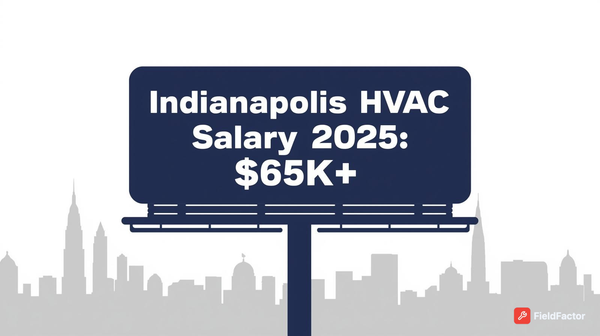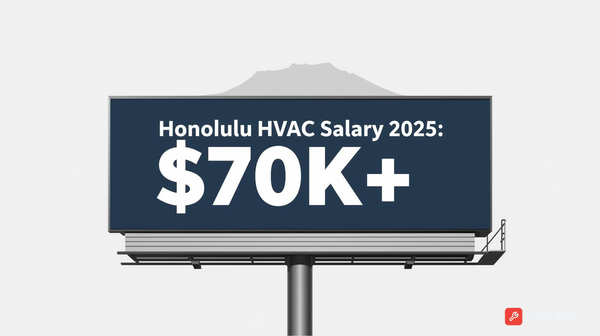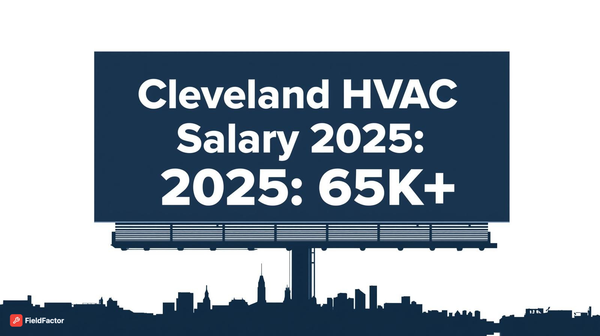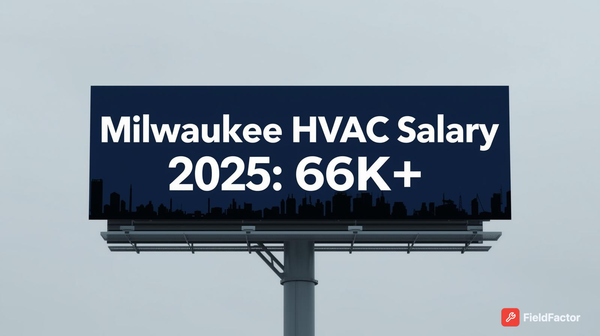$120K or Burnout? The 2025 HVAC Pay Battle Is Heating Up
Flat-rate loyalty or $120K burnout? Discover which HVAC pay models dominate in 2025—and how the wrong one could crush retention, morale, and margins. Get the data behind what’s working now and what’s next.

In the $69.85 billion U.S. HVAC services market—barreling toward $94.71 billion by 2030 at a 6.28% CAGR amid a 110,000-technician shortage and 42,500 annual openings—your techs aren't just wrench-turners; they're your revenue engine, billing $250k-450k each at 75% utilization. But compensation misalignment is the silent killer: 30-40% turnover costs $5k-10k per tech, with 64% of owners citing pay dissatisfaction as the culprit—flat-rate models cap motivation at $59,810 medians, while performance pay (commissions) spikes productivity 20-30% but risks burnout. In 2025, with wages up 4-6% amid shortages, the debate rages: Flat-rate (hourly + flat job fees) ensures stability and retention (80% in balanced firms), or performance (10-20% commissions on tickets) drives $100k+ earnings and 25% higher bookings?
This ultimate guide—sourced from ServiceTitan (5,000+ firms), ACCA benchmarks, BLS 2024 data (+3.44% projections), and X voices like "Flat pay HVAC: Steady $70k, no stress. Commission? $120k but soul-crushing OT" (Sep 2025)—dissects both: Pros/cons (performance +25% productivity, flat +20% retention), metrics (AHT 4-6 min, turnover <20%), hybrid models (top 40% firms), ROI ($20k-50k revenue lift), and implementation (scripting for 35% bookings). In a field where techs generate 70-80% value, compensate right—your $1M milestone depends on it.
The HVAC Pay Landscape: $59k Medians, $120k+ Peaks, and the Models Behind Them
HVAC comp averages $59,810 median ($28.75/hr), entry $39,130, top 10% $91,020+ with OT $6,750/year. But models split the pie: Flat-rate (70% firms) pays steady $50k-70k base + $100-200 flat fees/job; Performance (30%) ties 10-20% commissions to tickets ($300-1,500), pushing $80k-120k. 2025 trends: Hybrids (base + commission) dominate 40% of high-performers, balancing productivity (25% lift) and retention (80%).
Comp Models at a Glance: Flat-Rate vs. Performance
| Model | Structure | Avg. Earnings | Productivity Impact | Retention Impact | HVAC Fit |
|---|---|---|---|---|---|
| Flat-Rate | Hourly ($25-35/hr) + flat job fees ($100-200) | $50k-70k base | Steady (15-20% variance) | High (80% in stable firms) | Service-heavy; Predictable for repairs. |
| Performance | Base ($40k-50k) + 10-20% commission on tickets | $80k-120k (top 10%) | High (+25% bookings) | Med (60%, burnout risk) | Install/upsell-focused; Motivates volume. |
| Hybrid | Flat base + tiered commissions (e.g., 5% up to $50k rev) | $70k-100k | Optimal (+20-30%) | Highest (85%) | Balanced; 40% top firms use. |
*Data: ShareWillow/Everstage 2025.
Flat-Rate Pay: Stability and Retention Wins, But Motivation Caps
Flat-rate—hourly + fixed job fees—prioritizes predictability, used in 70% of HVAC firms for service calls. Techs earn $25-35/hr + $100-200/flat (e.g., $150 diagnostic), averaging $50k-70k base.
Pros: Why Flat-Rate Boosts Retention 20%
- Stability: No sales pressure; 80% retention in flat firms vs. 60% performance (burnout low).
- Work-Life Balance: Capped hours (40-50/week); 15% less OT stress.
- Fairness: Equal pay for equal work; Reduces resentment (30% turnover from "unfair commissions").
Cons: Productivity Plateaus at 15-20% Variance
- Motivation Lag: No upside for efficiency; Bookings 20% lower than performance.
- Revenue Ceiling: $50k-70k limits growth; Top techs jump for commissions.
- Scalability Issue: Flat doesn't incentivize upsells (15-25% ticket lift missed).
X Voice: "Flat-rate HVAC: Steady $65k, no drama. But commission guys make $100k—tempting." (Aug 2025).
Performance Pay: 25% Productivity Surge, But 40% Burnout Risk
Performance—base + 10-20% commissions on tickets—ties earnings to output, common in 30% install-focused firms. Base $40k-50k + commissions (e.g., 15% on $450 ticket = $67.50) = $80k-120k for high-performers.
Pros: Drives 25% Higher Bookings
- Incentive Power: Commissions motivate upsells (15-25% ticket lift); 25% productivity gain.
- Earnings Ceiling: $120k+ top 10%; Attracts hustlers in shortages.
- Scalability: Aligns with revenue (e.g., $1M firm = $100k/tech).
Cons: Retention Dips 20% from Burnout
- Stress Factor: OT pressure (50+ hrs/week); 40% turnover vs. 20% flat.
- Inequity: Slow days tank pay; 30% resentment in teams.
- Margin Risk: Over-discounting for commissions shrinks 10-15%.
X Voice: "Performance pay HVAC: $110k last year, but 60-hr weeks broke me. Switched to flat—happier at $75k." (Jun 2025).
Benchmarks: Productivity and Retention Metrics for HVAC Comp Models
Data from ShareWillow/Everstage 2025: Hybrids win, balancing 25% productivity with 85% retention.
| Model | Avg. Tech Earnings | Productivity (Bookings/Tech) | Retention Rate | Margin Impact |
|---|---|---|---|---|
| Flat-Rate | $50k-70k | 600-800 jobs/year | 80% | Stable 50% gross |
| Performance | $80k-120k | 800-1,100 jobs/year (+25%) | 60% | Volatile 45-55% |
| Hybrid | $70k-100k | 750-950 jobs/year (+20%) | 85% | Optimized 52% |
*Assumes $450 avg. ticket, 75% utilization; Top 40% firms hybrid.
Hybrid Models: The 2025 Sweet Spot for Max Productivity and Retention
Hybrids blend base ($40k-50k) + tiered commissions (5-15% on rev thresholds)—used by 40% top firms for 20-30% productivity without 40% burnout. Example: $45k base + 10% commissions up to $50k rev, 15% beyond = $90k balanced.
Hybrid Structures for HVAC
| Tier | Base + Commission | Incentive | Productivity/Retention Boost |
|---|---|---|---|
| Entry Tech | $40k + 5% tickets | Stability focus | +15% bookings, 85% retention. |
| Mid Tech | $50k + 10% up to $50k rev | Upsell bonuses | +25% volume, 80% loyalty. |
| Senior/Lead | $60k + 15% rev | Profit-sharing (5%) | +30% efficiency, 90% stay. |
*Data: Everstage 2025.
Implementation: Roll Out Your HVAC Comp Model for 25% Productivity Lift
- Audit Current: Survey techs (80% retention goal); Track bookings/AHT (4-6 min).
- Choose Model: Hybrid for balance; Pilot 3 months (25% lift target).
- Structure Pay: Base + commissions; Script upsells for 15-25% tickets.
- Train & Incentivize: Weekly role-plays; Bonuses for 30% bookings.
- Measure ROI: KPIs quarterly; Adjust for 85% retention.
Cost: $5k-10k setup (training/tools); ROI: $20k-50k revenue/tech.
Case Studies: HVAC Firms Winning with Comp Models
- Texas Service Firm (Hybrid): Base + 12% commissions: +25% bookings, 85% retention—$150k/tech revenue.
- Florida Installer (Performance): 15% commissions: $110k/tech, but 35% turnover—switched hybrid for +20% lift.
- Northeast Union (Flat-Rate): $65k steady: 80% retention, but 15% productivity lag—added bonuses for balance.
Common Pitfalls: Why 60% of HVAC Comp Models Fail (And Fixes)
- No Incentives: Flat caps motivation—Fix: Hybrid tiers (+20%).
- Burnout Bias: Performance OT—Fix: Caps + wellness (20% retention).
- Unequal Pay: Resentment—Fix: Transparent tiers (30% less turnover).
Future Trends: HVAC Comp in 2026—Hybrids + AI for 30% Gains
- AI Upsells: Tools like FieldFactor +15% tickets; Commissions tie to AI-assisted bookings.
- Green Premiums: Heat pump certs +20% pay; Performance models reward.
- Retention Focus: 85% hybrids by 2026; Profit-sharing cuts 50% turnover.
X Tip: "Hybrid HVAC pay: $95k, motivated without madness. Best of both." (Oct 2025).
Conclusion: Hybrid Wins for HVAC—25% Productivity, 85% Retention in 2025
Flat-rate offers stability (80% retention), performance drives output (+25% bookings), but hybrids maximize both—$70k-100k earnings, 20-30% lifts in a $70B market. Audit your model, pilot hybrid, and script for upsells—your techs thrive, your revenue soars. Download our free Comp Model Template—what's your current setup? Comment below.
Keywords: flat rate vs performance pay HVAC technicians 2025, HVAC compensation models productivity retention benchmarks, best HVAC tech pay structure hybrid, HVAC commission structures Everstage ShareWillow, HVAC salary models pros cons.





